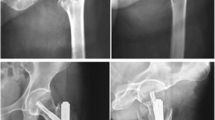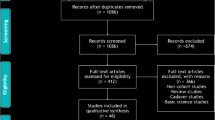Abstract
Purpose
To compare the intraoperative procedural efficiency of antegrade and retrograde locked intramedullary nailing of diaphyseal femur fractures without intraoperative fluoroscopy, power reaming devices and fracture tables.
Methods
A secondary analysis of prospectively collected data was conducted on 238 isolated diaphyseal femur fractures fixed with SIGN Standard and Fin nails within three weeks of injury. The data included baseline patient and fracture characteristics, nail type and diameter, fracture reduction methods, operative times and outcome measures.
Results
There were 84 and 154 fractures in the antegrade and retrograde groups respectively. Both groups were similar vis-a-vis baseline patient and fracture characteristics. Closed reduction of the fractures was significantly easier for retrograde than an antegrade approach. The retrograde approach more readily permitted the use of Fin nails. The mean nail diameter used for retrograde was significantly larger than that for antegrade. The time taken to achieve retrograde nailing was significantly lesser than that of antegrade. There was no statistically significant difference between the outcomes of the two groups.
Conclusion
In the absence of expensive fracture-surgery gadgets, retrograde nailing offers many procedural advantages over antegrade, such as easier closed reduction and canal reaming, the greater possibility of using the Fin nail with fewer interlocking screws and shorter operative times. However, we acknowledge the lack of randomisation and the presence of an unequal number of fractures in the two groups as limitations of this study.





Similar content being viewed by others
Data availability
The datasets used and/or analysed during the current study are available from the corresponding author on reasonable request.
References
Agarwal-Harding KJ, von Keudell A, Zirkle LG, Meara JG, Dyer GSM (2016) Understanding and addressing the global need for orthopaedic trauma care. J Bone Joint Surg Am 98-A(21):1844–53. https://doi.org/10.2106/JBJS.16.00323
Bach O (2004) Musculoskeletal trauma in an East African public hospital. Injury 35(4):401–406. https://doi.org/10.1016/S0020-1383(03)00290-0
Gellman RE (2016) Fracture care challenges in austere and humanitarian environments. Curr Trauma Rep 2:100–105. https://doi.org/10.1007/s40719-016-0046-y
Phillips J, Zirkle LG, Gosselin RA (2012) Achieving locked intramedullary fixation of long bone fractures: technology for the developing world. Int Orthop 36:2007–2013. https://doi.org/10.1007/s00264-012-1625-3
Liu MB, Ali SH, Haonga BT, Eliezer EN, Albright PD, Morshed S, Shearer D (2019) Surgical Implant Generation Network (SIGN) Fin nail versus SIGN standard intramedullary nail for distal diaphyseal femur fractures treated via retrograde approach. Injury 50(10):1725–1730. https://doi.org/10.1016/j.injury.2019.09.009
Njoroge AN, Mwangi HR, Lelei LK (2013) Functional outcomes of the knee after retrograde and antegrade intramedullary nailing for femoral shaft fractures. An Afr Surg 10(2):12–16
Toluse AM, Ikem IC, Akinyoola AL, Esan O, Asuquo JE (2015) Antegrade versus retrograde approach to interlocking nail fixation of the femoral diaphyseal fractures: is there a difference in time to union? Niger Postgrad Med J 22(1):41–44
Adesina SA, Eyesan SU, Amole IO, Akinwumi AI, Awotunde OT, Durodola AO, Owolabi JI (2022) Solid locked intramedullary nailing for expeditious return of bone-setting-induced abnormal fracture union victims to work in South-western Nigeria. Sci Rep 12:21432. https://doi.org/10.1038/s41598-022-25862-3
Adesina SA, Eyesan SU, Ikem IC, Anipole OA, Amole IO, Akinwumi AI, Bamigboye PO, Durodola AO (2021) Radiation-free interlocking intramedullary nailing of three-hundred and seventy long bone fractures in Ogbomoso. Nigeria Sci Rep 11(1):10070. https://doi.org/10.1038/s41598-021-89544-2
Adesina SA, Amole IO, Owolabi JI, Oyewusi OO, Adefokun IG, Eyesan SU (2023) Locked intramedullary nailing of open fractures in resource-poor settings: a prospective observational study of challenges and functional outcomes in 101 fractures at Ogbomoso. Nigeria BMC Musculoskelet Disord 24:170. https://doi.org/10.1186/s12891-023-06271-7
Adesina SA, Eyesan SU, Amole IO, Awotunde OT, Akinwumi AI, Durodola AO, Ikem IC (2021) Closed reduction and locked intramedullary nailing of diaphyseal long bone fractures without intraoperative imaging and fracture table. Int Orthop 46:51–59. https://doi.org/10.1007/s00264-021-05091-5
Rodriguez-Fontan F, Tucker NJ, Strage KE, Mauffrey C, Parry JA (2022) Antegrade versus retrograde nailing of proximal femur fractures: a cortical diameter based study. J Orthop 12(34):385–390. https://doi.org/10.1016/j.jor.2022.10.005
Herrera A, Albareda J, Gabarre S, Ibarz E, Puértolas S, Mateo J, Gracia L (2020) Comparative analysis of the biomechanical behavior of anterograde/retrograde nailing in supracondylar femoral fractures. Injury 51(Suppl 1):S80–S88. https://doi.org/10.1016/j.injury.2020.02.010
Andrzejewski K, Panasiuk M, Grzegorzewski A, Synder M (2013) Comparison of knee function in patients with a healed fracture of the femoral shaft fixed with retrograde and antegrade intramedullary nailing. Ortop Traumatol Rehabil 15(5):395–405. https://doi.org/10.5604/15093492.1084241
Brewster J, Grenier G, Taylor BC, Carter C, Degenova D, Ebaugh MP, Halverson A (2020) Long-term comparison of retrograde and antegrade femoral nailing. Orthopedics 43(4):e278–e282. https://doi.org/10.3928/01477447-20200415-04
Kim JW, Oh CW, Oh JK, Park KH, Kim HJ, Kim TS, Seo I, Park EK (2018) Treatment of infra-isthmal femoral fracture with an intramedullary nail: Is retrograde nailing a better option than antegrade nailing? Arch Orthop Trauma Surg 138(9):1241–1247. https://doi.org/10.1007/s00402-018-2961-6
Hussain N, Hussain FN, Sermer C, Kamdar H, Schemitsch EH, Sternheim A, Kuzyk P (2017) Antegrade versus retrograde nailing techniques and trochanteric versus piriformis intramedullary nailing entry points for femoral shaft fractures: a systematic review and meta-analysis. Can J Surg 60:19–29. https://doi.org/10.1503/cjs.000616
Zhang F, Zhu L, Li Y, Chen A (2015) Retrograde versus antegrade intramedullary nailing for femoral fractures: a meta-analysis of randomized controlled trials. Curr Med Res Opin 31:1897–1902. https://doi.org/10.1185/03007995.2015.1078783
von Kaeppler EP, Donnelley CA, Roberts HJ, Eliezer EN, Haonga BT, Morshed S, Shearer DW (2021) Assessment of clinical and radiographic outcomes following retrograde versus antegrade nailing of infraisthmic femoral shaft fractures without the use of intraoperative fluoroscopy in Tanzania. OTA Int 4(2):e125. https://doi.org/10.1097/OI9.0000000000000125
El-Seedy AI, Zaki EM, El-Sheikh IF, Sakr SA (2022) Long-term functional outcome of the knee after antegrade versus retrograde intramedullary nailing for femoral fracture. Menoufia Med J 35:899–904. https://doi.org/10.4103/mmj.mmj_240_21
Garbarino LJ, Gold PA, Sodhi N, Anis HK, Ehiorobo JO, Boraiah S, Danoff JR, Rasquinha VJ, Higuera-Rueda CA, Mont MA (2019) The effect of operative time on in-hospital length of stay in revision total knee arthroplasty. Ann Transl Med 7(4):66. https://doi.org/10.21037/atm.2019.01.54
Ravi B, Jenkinson R, O’Heireamhoin S, Austin PC, Aktar S, Leroux TS, Paterson M, Redelmeier DA (2019) Surgical duration is associated with an increased risk of periprosthetic infection following total knee arthroplasty: a population-based retrospective cohort study. E Clin Med 16(2019):74–80. https://doi.org/10.1016/j.eclinm.2019.09.015
Meinberg EG, Agel JMA, Roberts CS, Karam MD, Kellam JF (2018) Fracture and dislocation classification compendium - 2018. J Orthop Trauma 32(Suppl 1):S1-170. https://doi.org/10.1097/BOT.0000000000001063
Zirkle LG, Shearer D (2009) SIGN technique for retrograde and antegrade approaches to femur. Tech Orthop 24:247–252. https://doi.org/10.1097/BTO.0b013e3181c3e617
Wu H, Liu M, Challa ST, Morshed S, Eliezer EN, Haonga BT, Zirkle L, Shearer DW (2019) Development of squat-and-smile test as proxy for femoral shaft fracture-healing in patients in Dar es Salaam. Tanzania J Bone Joint Surg Am 101(4):353–359. https://doi.org/10.2106/JBJS.18.00387
Maharjan R, Pokharel B, Kalawar RPS, Rijal R, Baral D (2021) Squat and smile assessment in predicting healing of lower limb fractures fixed with a SIGN nail. J Clin Orthop Trauma 19:32–41. https://doi.org/10.1016/j.jcot.2021.05.001
Ogunlusi JD, St Rose RS, Davids T (2010) Interlocking nailing without imaging: the challenges of locating distal slots and how to overcome them in SIGN intramedullary nailing. Int Orthop 34(6):891–895. https://doi.org/10.1007/s00264-009-0882-2
Yang TC, Tzeng YH, Wang CS, Lin CC, Chang MC, Chiang CC (2021) “Ratio of fracture site diameter to isthmus femoral canal diameter” as a predictor of complication following treatment of infra-isthmal femoral shaft fracture with antegrade intramedullary nailing. Injury 52(4):961–966. https://doi.org/10.1016/j.injury.2020.12.034
Winquist RA, Hansen ST Jr, Clawson DK (1984) Closed intramedullary nailing of femoral fractures. A report of five hundred and twenty cases. J Bone Joint Surg Am 66(4):529–39
Wolinsky PR, McCarty E, Shyr Y, Johnson K (1999) Reamed intramedullary nailing of the femur: 551 cases. J Trauma 46(3):392–399. https://doi.org/10.1097/00005373-199903000-00007
Tahir M, Ahmed N, Faraz A, Shafiq H, Khan MN (2021) Comparison of open and closed nailing for femoral shaft fractures: a retrospective analysis. Cureus 13(6):e16030. https://doi.org/10.7759/cureus.16030
Daglar B, Gungor E, Delialioglu OM, Karakus D, Ersoz M, Tasbas BA, Bayrakci K, Gunel U (2009) Comparison of knee function after antegrade and retrograde intramedullary nailing for diaphyseal femoral fractures: results of isokinetic evaluation. J Orthop Trauma 23(9):640–644. https://doi.org/10.1097/BOT.0b013e3181a5ad33
Ostrum RF, Agarwal A, Lakatos R, Poka A (2000) Prospective comparison of retrograde and antegrade femoral intramedullary nailing. J Orthop Trauma 14:496–501. https://doi.org/10.1097/00005131-200009000-00006
Ricci WM, Bellabarba C, Evanoff B, Herscovici D, DiPasquale T, Sanders R (2001) Retrograde versus antegrade nailing of femoral shaft fractures. J Orthop Trauma 15:161–169. https://doi.org/10.1097/00005131-200103000-00003
Tornetta P 3rd, Tiburzi D (2000) Antegrade or retrograde reamed femoral nailing. a prospective, randomised trial. J Bone Joint Surg Br 82(5):652–4. https://doi.org/10.1302/0301-620x.82b5.10038
Dougherty PJ, Gherebeh P, Zekaj M, Sethi S, Oliphant B, Vaidya R (2013) Retrograde versus antegrade intramedullary nailing of gunshot diaphyseal femur fractures. Clin Orthop Relat Res 471(12):3974–3980. https://doi.org/10.1007/s11999-013-3058-8
Acknowledgements
The authors are deeply grateful to SIGN Fracture Care International and its founder and president, Lewis G. Zirkle, for the free donation of SIGN implants and training without which this study would not have been possible
Author information
Authors and Affiliations
Contributions
All the authors contributed to the study conception and design. Material preparation, data collection and analysis were performed by Adesina Stephen Adesope, Amole Isaac Olusayo, Oyewusi Oluwafemi Oyewole, Adefokun Imri Goodness, Odekhiran Ehimen Oluwadamilare and Adeniji David Opeyemi. The first draft of the manuscript was written by Adesina Stephen Adesope, and all the authors commented on previous versions of the manuscript. All the authors read and approved the final manuscript.
Corresponding author
Ethics declarations
Ethics approval
The study was approved by the Institutional Review Board of Bowen University Teaching Hospital, Ogbomoso, Oyo State Nigeria.
Consent to participate
Informed consent was obtained from all individual participants included in the study.
Consent for publication
The authors affirm that human research participants provided informed consent for the publication of the images in Fig. 3, 4 and 5.
Competing interests
The authors declare no competing interests.
Additional information
Publisher's note
Springer Nature remains neutral with regard to jurisdictional claims in published maps and institutional affiliations.
Rights and permissions
Springer Nature or its licensor (e.g. a society or other partner) holds exclusive rights to this article under a publishing agreement with the author(s) or other rightsholder(s); author self-archiving of the accepted manuscript version of this article is solely governed by the terms of such publishing agreement and applicable law.
About this article
Cite this article
Adesina, S.A., Amole, I.O., Oyewusi, O.O. et al. Locked intramedullary nailing of diaphyseal femur fractures without intraoperative fluoroscopy, fracture table and power reaming: retrograde affords greater procedural efficiency than antegrade approach. International Orthopaedics (SICOT) 47, 1845–1853 (2023). https://doi.org/10.1007/s00264-023-05832-8
Received:
Accepted:
Published:
Issue Date:
DOI: https://doi.org/10.1007/s00264-023-05832-8




